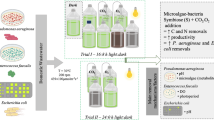Abstract
The potential of algal–bacterial symbiosis for the removal of carbon, nitrogen and phosphorus from five agro-industrial wastewaters was investigated in enclosed batch biodegradation tests using a mixed microalgae consortium and activated sludge as model microorganisms. The target wastewaters were obtained from potato processing (PW), fish processing (FW), animal feed production (MW), coffee manufacturing (CW) and yeast production (YW). The initial C/N/P ratio of the agro-industrial wastewater was correlated with its biodegradability. Thus, the highest removals of total organic carbon (TOC) and nitrogen were recorded in two fold diluted FW (64 ± 2 % and 85 ± 1 %, respectively), while the maximum P-PO4 3− removal achieved was 89 ± 1 % in undiluted PW. The biodegradable TOC was in most cases the limiting component in the treatment of the wastewaters evaluated. This study confirmed the potential of coupling carbon and nutrient recovery from agro-industrial effluents with the production of a valuable algal–bacterial biomass, despite their poor biodegradability.





Similar content being viewed by others
References
Bahr M, Stams AJM, De la Rosa F, García-Encina PA, Muñoz R (2011) Assessing the influence of carbon oxidation-reduction in algal-bacterial photobioreactors. Appl Microbiol Biotechnol 90:1527–1536
Bhatnagar A, Sillanpää M (2010) Utilization of agroindustrial and municipal wastes materials as potential adsorbents for water treatment: a review. Chem Eng J 157:277–296
Cabanelas ITD, Ruiz J, Arbib Z, Chinalia FA, Garrido-Pérez C, Rogalla F, Nascimiento IA, Perales JA (2013) Comparing the use of domestic wastewater for coupling microalgal production and nutrient removal. Bioresour Technol 131:429–436
Cai T, Park SY, Li Y (2013) Nutrient recovery from wastewater streams by microalgae: status and prospects. Renew Sust Energ Rev 19:360–369
Craggs RJ, Heubeck S, Lundquist TJ, Benemann JR (2011) Algal biofuels from wastewater treatment high rate algal ponds. Water Sci Technol 63:660–665
Dareioti MA, Dokianakis SN, Stamatelatou K, Zafiri C, Kornaros M (2009) Biogas production from anaerobic co-digestion of agroindustrial wastewaters under mesophilic conditions in a two stage process. Desalination 248:891–906
De Godos I, Blanco S, García-Encina PA, Becares E, Muñoz R (2009) Long term operation of high rate algae ponds for the bioremediation of piggery wastewaters at high loading rates. Bioresour Technol 100:4332–4339
De la Noüe J, Sevrin-Reyssac J, Mariojouls C, Marcel J, Sylvestre S (1994) Biotreatment of swine manure by intense lagooning during winter. Bioresour Technol 50:213–219
Dinsdale RM, Hawkes FR, Hawkes DL (1997) Comparison of mesophilic and termophilic upflow anaerobic sludge blanket reactors treating instant coffee production wastewater. Wat Res 31:163–169
Drogui P, Asselin M, Brar SK, Benmoussa H, Blais JF (2008) Electrochemical removal of pollutants from agro-industry wastewaters. Sep Purif Technol 61:301–310
Eaton AD, Clesceri LS, Greenberg AE (2005) Standard methods for the examination of water and wastewater, 21st edn. American Public Health Association/American Water Works Association/ Water Environment Federation, Washington, DC
Eurostat (2008) http://appsso.eurostat.ec.europa.eu/nui/submitViewTableAction.do?dvsc (consulted 21.08.2013)
González LE, Cañizares RO, Baena S (1997) Efficiency of ammonia and phosphorus removal from a Colombian agroindustrial wastewater by the microalgae Chlorella vulgaris and Scenedesmus dimorphus. Bioresour Technol 60:259–262
González C, Marciniak J, Villaverde S, García-Encina PA, Muñoz R (2008) Microalgae-based processes for the biodegradation of pretreated piggery wastewaters. Appl Microbiol Biotechnol 80:891–898
González C, Molinuevo-Salces B, García-González MC (2011) Nitrogen transformations under different conditions in open systems by means of microalgae-bacteria consortium treating pig slurry. Bioresour Technol 102:960–966
Grobelaar JU (2004) Algal nutrition: mineral nutrition. In Richmond, A.: Handbook of microalgal culture: biotechnology and applied phycology. Blackwell, Oxford, pp. 97–115
Guieysse B, Borde X, Muñoz, Hatti-Kaul R, Nugier-Chauvin C, Patin H, Mattiasson B (2002) Influence of the initial composition of algal-bacterial microcosms on the degradation of salicylate in a fed-batch culture. Biotechnol Lett 24:531–538
Metcalf and Eddy (2003) Wastewater engineering and reuse, 4th edn. McGraw-Hill
Muñoz R, Guieysse B (2006) Algal-bacterial processes for the treatment of hazardous contaminants: a review. Water Res 40:2799–2815
Muñoz R, Jacinto MSA, Guieysse B, Mattiasson B (2005) Combined carbon and nitrogen removal from acetonitrile using algal-bacterial reactors. Appl Microbiol Biotechnol 67:609–707
Olguín EJ (2003) Phycoremediation: key issues for cost-effective nutrient removal processes. Biotechnol Adv 22:81–91
Oswald WJ (1988) Micro-algae and waste-water treatment. In: Borowitzka MA, Borowitzka LJ (eds) Micro-algal biotechnology. Cambridge University Press, Cambridge, pp 305–328
Rawat I, Ranjith Kumar R, Mutanda T, Bux F (2011) Dual role of microalgae: phycoremediation of domestic wastewater and biomass for sustainable biofuels production. Appl Energy 88:3411–3424
Rovirosa N, Sánchez E, Benítez F, Travieso L, Pellón A (1995) An integrated system for agricultural wastewater treatment. Wat Sci Tech 32:165–171
Rusten B, Sahu AK (2011) Microalgae growth for nutrient recovery from sludge liquor and production of renewable bioenergy. Water Sci Technol 64:1195–1201
Wilkie AC, Mulbry WW (2002) Recovery of dairy manure nutrients by benthic freshwater algae. Bioresour Technol 84:81–91
Yan C, Zhang L, Luo X, Zheng Z (2013) Effects of various LED light wavelengths and intensities on the performance of purifying synthetic domestic sewage by microalgae at different influent C/N ratios. Ecol Eng 51:24–32
Acknowledgments
This research was financially supported by INIA through the Institute of Agriculture Technology of Castilla y León (Project Ref RTA2010-00087-C02-02) by the Ministry of Economy and Competitiveness (CONSOLIDER-CSD 2007-00055) and the Regional Government of Castilla y Leon (GR76). Araceli Crespo, Sara Santamarta, Silvia Arranz and Jose María Bueno are also gratefully acknowledged for their practical assistance.
Author information
Authors and Affiliations
Corresponding author
Rights and permissions
About this article
Cite this article
Posadas, E., Bochon, S., Coca, M. et al. Microalgae-based agro-industrial wastewater treatment: a preliminary screening of biodegradability. J Appl Phycol 26, 2335–2345 (2014). https://doi.org/10.1007/s10811-014-0263-0
Received:
Revised:
Accepted:
Published:
Issue Date:
DOI: https://doi.org/10.1007/s10811-014-0263-0




